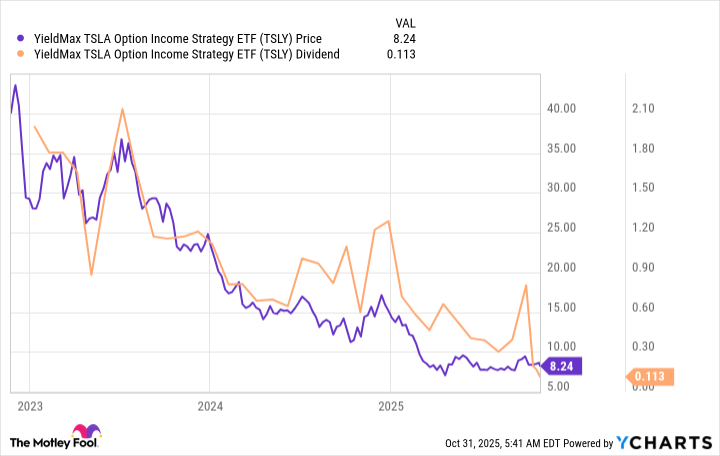Focusing on dividends is a tried-and-true way to invest. That said, there are different approaches that fall under the dividend moniker. If you are looking at dividend exchange-traded funds (ETFs) here are two of the best options, which use dividends in slightly different ways. And then I'll offer an example of a dividend ETF that most investors would do best to avoid.
Two approaches to the same dividend theme
If you follow the normal dividend logic, you are looking for income and Schwab US Dividend Equity ETF (SCHD +0.79%) is going to be a good choice for you. It offers a dividend yield of around 3.8% right now, which is well above the 1.2% you'd collect from an S&P 500 index ETF. That said, you can find higher-yielding ETFs pretty easily. However, they probably won't be able to mimic what Schwab US Dividend Equity ETF has to offer.

Image source: Getty Images.
In a nutshell, Schwab US Dividend Equity ETF does what you would likely do if you were buying individual dividend stocks. It uses a fairly complex screen to find companies that have good businesses, are growing, have attractive yields, and have a history of growing their dividends.

NYSEMKT: SCHD
Key Data Points
It gets there by only looking at stocks with at least 10 years' worth of annual dividend increases and then creating a composite score for each company. The composite score looks at financial metrics that assess company quality, financial strength, dividend yield, and dividend growth. The 100 companies with the best scores get into the ETF. And it has an expense ratio of only around 0.06%, which is very low. Over time, Schwab US Dividend Equity ETF has provided a good combination of yield, capital appreciation, and dividend growth.
Some dividend investors, however, focus more on dividend growth than yield. This is a slightly different variation on the dividend theme that Vanguard Dividend Appreciation ETF (VIG +0.62%) is purpose-built to serve. It takes all of the companies that have increased their dividends for at least 10 years. It then lops off the highest-yielding 25% of the list, keeping the rest. It is definitely not looking to maximize yield, which is highlighted by its 1.6% dividend yield.
The ETF owns over 300 stocks, so it has a fair amount of diversification. And its expense ratio is an even lower 0.05%. Over time, this ETF has provided investors with both capital appreciation and dividend growth, which is exactly what it is attempting to do.

NYSEMKT: VIG
Key Data Points
One of these two well-respected ETFs will likely fit your needs if you are focused on dividends. What you need to avoid is reaching for yield and, in turn, taking on more risk than you may think. That's where YieldMax TSLA Option Income Strategy ETF comes in.
Warning: Don't think short term with dividends
You can find high-yield ETFs pretty easily, but you need to ask how they are getting those yields and what the trade-off is going to be. In some cases, the yield is so high that capital appreciation is likely to be minimal. That might be a worthwhile trade-off if you don't care about growing your capital, but it is a risky decision because inflation will slowly erode the value of your dollars (the dividend dollars and the value of your capital).
Even more troubling are cases where the yield is so high that the value of the ETF falls over time. As the chart above shows, this is the problem with the YieldMax TSLA Option Income Strategy ETF (TSLY +2.93%), which trades options around Tesla stock.
This ETF's stated objective is income with a secondary goal of seeking "exposure to the share price of the common stock of Tesla." If you bought this ETF, you'd have generated a huge income stream, but your capital would have been eroded and that income stream would have also trended lower.
It is a shockingly complex ETF (it doesn't even own Tesla stock) and the expense ratio is a huge 0.99%, which is very expensive. But it is just one of the many ultra-high yield single stock ETFs that YieldMax offers, all of which present diversification issues in addition to the risk posed from the ultra high yield.
This series of ETFs might be interesting if you own the underlying stock and wish to generate income without having to sell the stock, but most investors should focus on easier-to-understand dividend ETFs that also provide more reliable income streams and performance.
Simple is better when it comes to dividend investing
YieldMax TSLA Option Income Strategy ETF is an extreme example of an ETF that is likely to be too risky for most investors. And there are more out there, where stretching for yield will leave you missing out on important factors like dividend growth and capital appreciation.
Tread carefully and consider starting with Schwab US Dividend Equity ETF (for yield) and Vanguard Dividend Appreciation ETF (for dividend growth). You may decide on other options, but these two ETFs are great targets to which you can compare all of your other choices.
